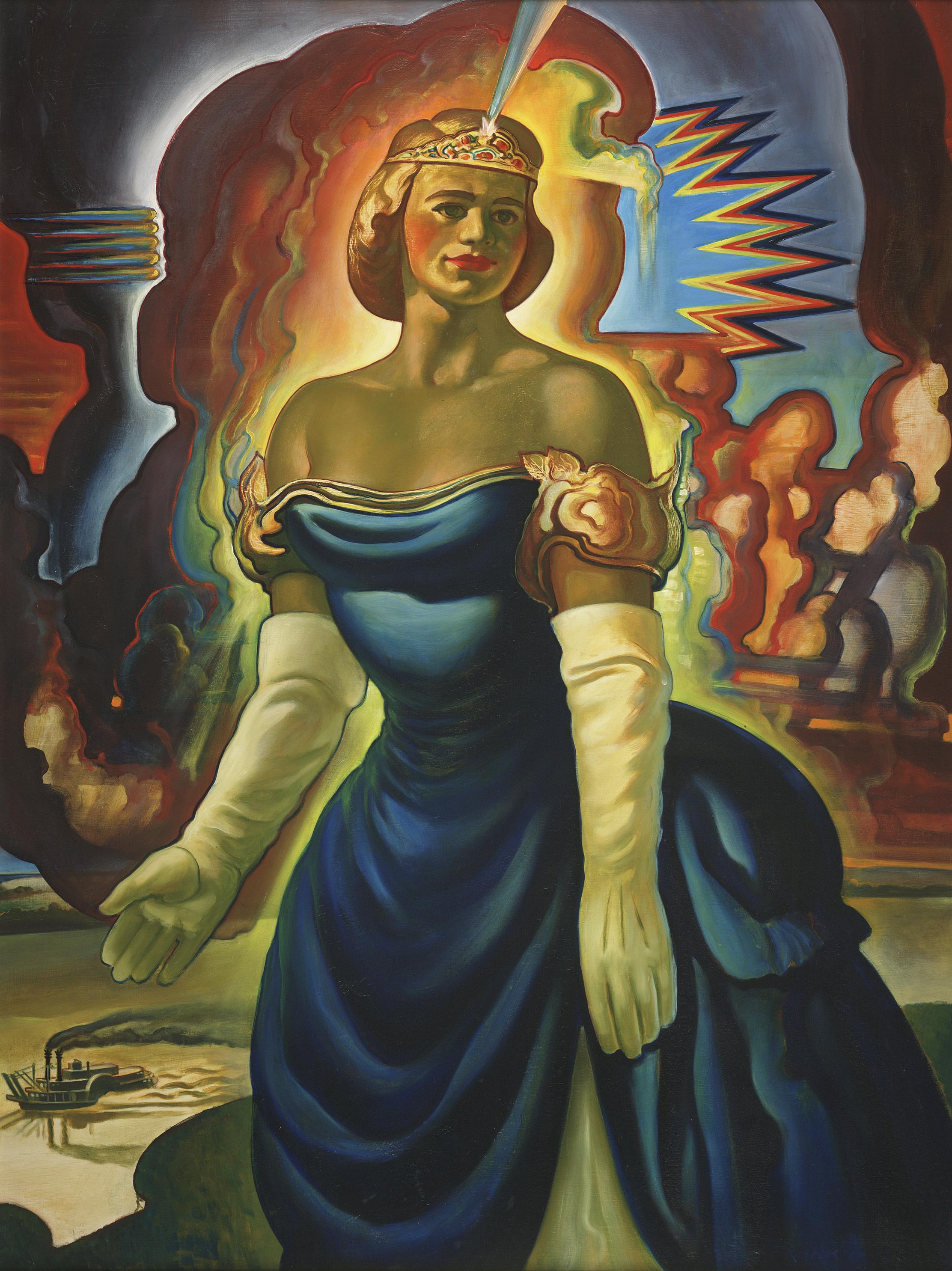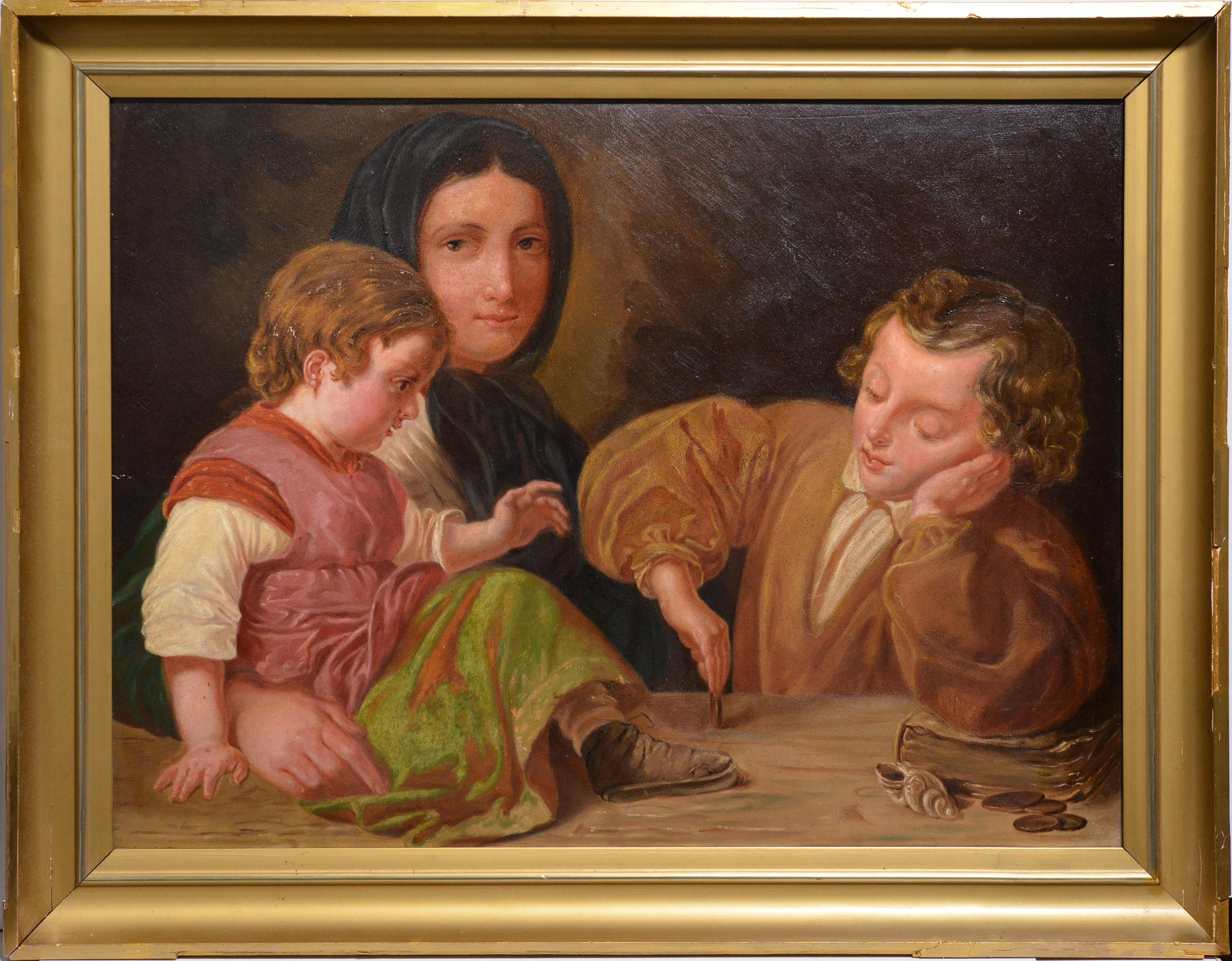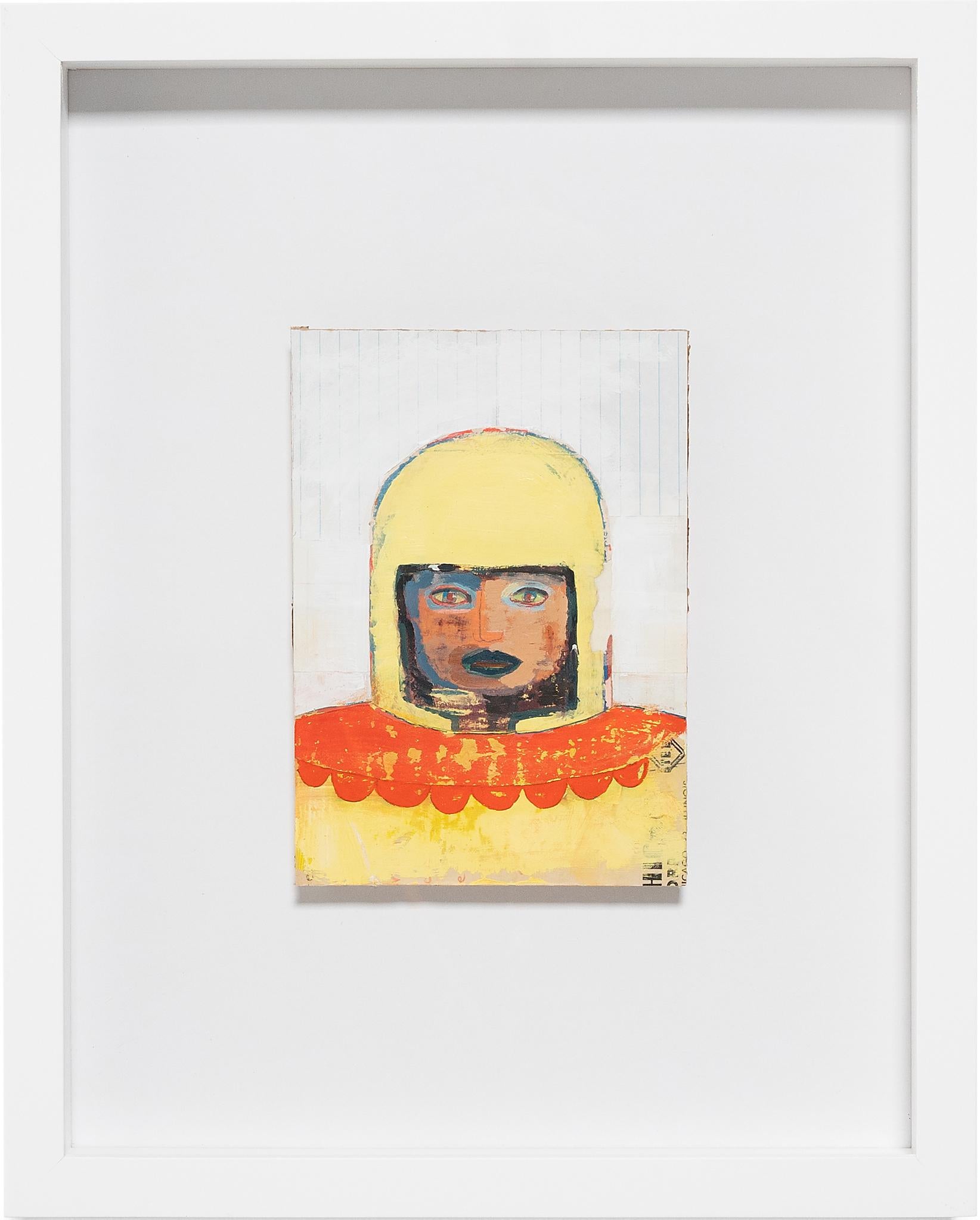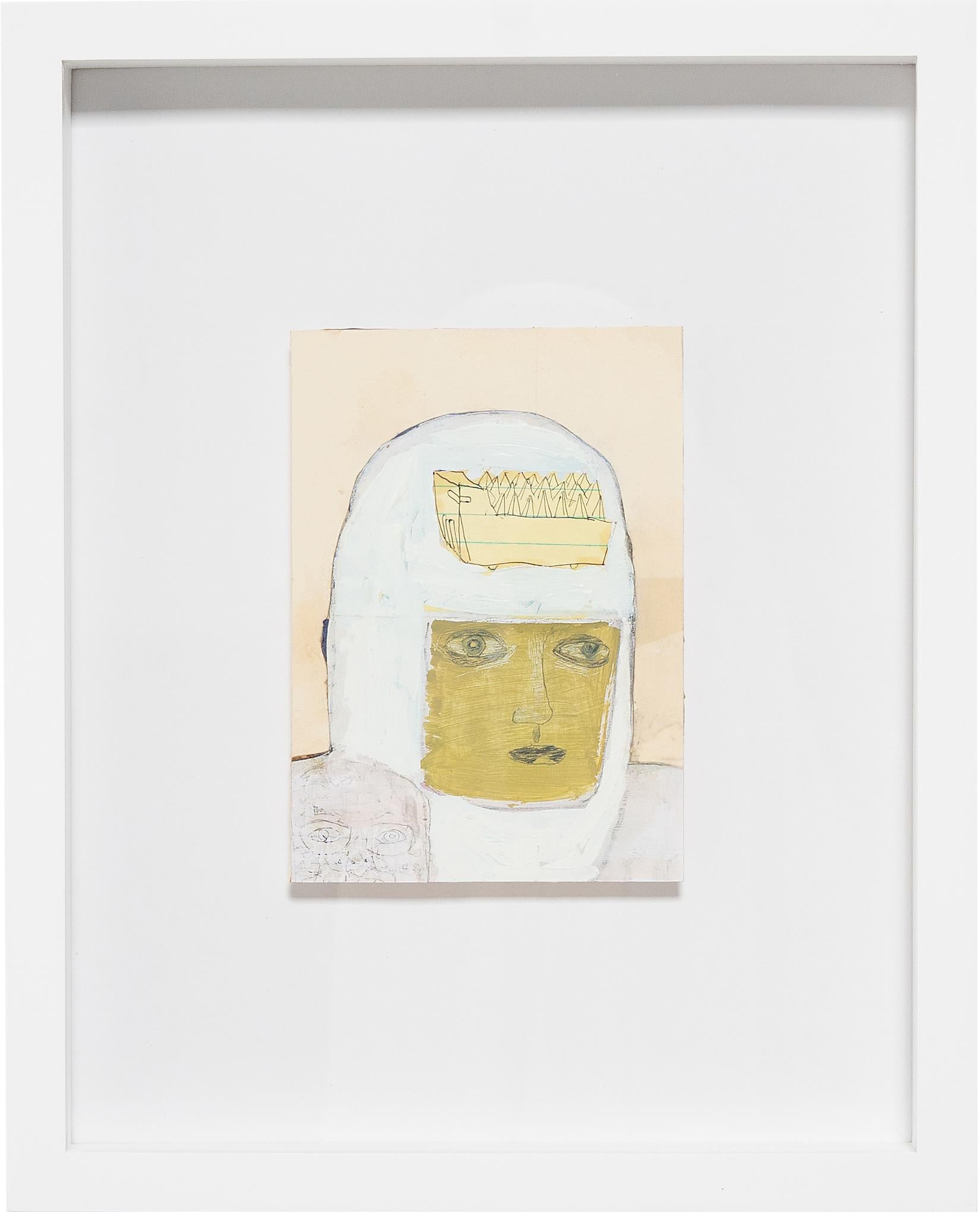Items Similar to Portrait of a Girl With Blue Necklace by Swedish Artist Emma Ekwall
Want more images or videos?
Request additional images or videos from the seller
1 of 7
Emma EkwallPortrait of a Girl With Blue Necklace by Swedish Artist Emma Ekwalllate 1800s
late 1800s
About the Item
"The Girl with Blue Necklace" is an enchanting portrait of a young girl, depicted by the Swedish artist Emma Ekwall. She was sister of the famous artist Knut and Hugo and Gustaf Ekwall.
She studied at The Royal Swedish Academy of Fine Arts between 1865 and 1870 and earned fame as the first woman to receive the royal medal in 1871. Her artistic journey included time spent in Munich and Leipzig, enriching her skills and perspective. Ekwall's oeuvre encompasses portraits, floral still lifes, and genre paintings, with a special fondness for portraying children, where her talent shone brightest.
The portrait in question features a young girl in a red cap, her gaze captivating with innocence and a gentle serenity. The blue necklace, possibly reminiscent of lapis lazuli, but more likely of a simpler origin, likely colored bone or wooden beads, aligning with the subject's peasant roots.
Emma Ekwall's work is celebrated in prestigious collections, including the Nationalmuseum in Stockholm, Norrköping's Art Museum, and the Kalmar Art Museum.
oil on board
signed E A Ekwall
unframed 18 x 11.5 cm
framed 28 x 22.5 cm
Condition:
Restored by a professional art conservator in Stockholm 2024.
Literature:
Konstens värld, page 2308.
Condition:
Recently restored by a professional art conservator in Stockholm, this exquisite piece has undergone a meticulous cleaning, a fresh application of varnish, and a few minor retouches to bring back its original splendor.
- Creator:Emma Ekwall (1838 - 1925, Swedish)
- Creation Year:late 1800s
- Dimensions:Height: 11.03 in (28 cm)Width: 8.67 in (22 cm)
- Medium:
- Period:
- Condition:Recently restored by a professional art conservator in Stockholm, this exquisite piece has undergone a meticulous cleaning, a fresh application of varnish, and a few minor retouches to bring back its original splendor. Original gold frame included.
- Gallery Location:Stockholm, SE
- Reference Number:1stDibs: LU1445213897342
About the Seller
5.0
Platinum Seller
These expertly vetted sellers are 1stDibs' most experienced sellers and are rated highest by our customers.
Established in 2020
1stDibs seller since 2020
118 sales on 1stDibs
Typical response time: <1 hour
Associations
International Confederation of Art and Antique Dealers' Associations
- ShippingRetrieving quote...Ships From: Stockholm, Sweden
- Return PolicyA return for this item may be initiated within 2 days of delivery.
More From This SellerView All
- On the Sea (På havet, 1911) by Swedish Carl WilhelmsonLocated in Stockholm, SEThe painting På Havet (On the Sea) by Carl Wilhelmson, created in 1911, stands as a remarkable testament to the artist's profound connection with the s...Category
1910s Modern Figurative Paintings
MaterialsWood Panel, Oil
- Highly Detailed Oil Painting - Old Woman Knitting Attributed to David MoniesLocated in Stockholm, SEEssay: David Monies (1812-1894) was a danish artist, specializing in portrait and genre painting. His father Salomon Monies (1786-1853) was a Jewish busin...Category
1840s Realist Figurative Paintings
MaterialsCanvas, Oil
- An Italian Man With Hat and Scarf by Italian Artist Giuseppe GiardinelloLocated in Stockholm, SEFor sale is a beautiful small portrait by the Italian artist Giuseppe Giardinello, whose life spanned from 1887 to 1920. This work of art is a remarkable representation of Giardinell...Category
Early 20th Century Post-Impressionist Portrait Paintings
MaterialsWood Panel, Oil
- The Pipe Smoker, Portrait by Italian Artist Giuseppe GiardinelloLocated in Stockholm, SEThis captivating small portrait is the work of Italian artist Giuseppe Giardinello, who lived from 1887 to 1920. Giardinello's talent for capturing the essence of his subjects is ful...Category
Early 20th Century Portrait Paintings
MaterialsWood Panel, Oil
- A Young Girl Reading a Book, Pointillist ArtistLocated in Stockholm, SE"A Young Girl Reading a Book" is a captivating portrait by Swedish artist Gustaf Arnolds. Arnolds was a prolific painter whose roots began in Vingåker and later in Ronneby from his teenage years. His educational journey in art took him through prestigious institutions such as Althins målarskola and the Tallbergska grafikskolan in Stockholm, followed by a significant period at the Konstakademien, Stockholm, between 1904 and 1909. His talent and dedication were recognized early on, earning him a scholarship to Paris, a city that would deeply influence his artistic direction. This particular work, likely painted shortly after his return to Sweden, reveals a profound influence from his time in Paris. It portrays a young girl absorbed in reading a book, a simple yet profound subject that Arnolds imbues with a sense of tranquility and introspection. The background hints at a serene landscape, dotted with quaint houses, a nod to the everyday beauty surrounding us. What sets this piece apart is Arnolds’ technique, reminiscent of pointillism but distinguished by longer, more expressive brush strokes that add a vibrant texture and depth to the canvas. This method showcases Arnolds' unique adaptation of the techniques he encountered during his Parisian studies, particularly during his interactions with Nils Dardel...Category
1930s Pointillist Portrait Paintings
MaterialsMasonite, Oil
- Cubist Portrait of Gabriele Varese (in Italian uniform), 1919Located in Stockholm, SEDick Beer (b. London 1893 - d. Stockholm 1938) Portrait of Gabriele Varese (in Italian uniform), 1919 oil on canvas mounted on panel 116 x 90 cm stamp signature Exhibited: Solo exhibition, Stockholm, Nov-Dec 1917; The Royal Academy Stockholm 1973; Åmells Konsthandel – En internationell kubist, Stockholm & London 2008 Hälsinglands Museum 2011 Millesgården – Dick Beer – Impressionist & Kubist, 2012 Provenance: Within the family Beer until today Dick Beer was born in 1893 in London as Richard Beer, the youngest of five brothers. His father, John Beer (1853-1906), was a watercolourist who was born in Stockholm and had left Sweden at the age of 17. John Beer instructed his sons in drawing and painting, among other things. A number of sketchbooks bear testimony to the boys’ talent. Dick Beer’s parents died in 1906 and 1907. Barely 15 years old, Beer arrived in Sweden as an orphan. First he lived with relatives and finally he ended up at Reverend Laurell in Västergötland. Dick Beer began his artistic studies at the Althin School of Painting in Stockholm in 1908 and continued at the Royal Academy of Arts in the autumn of 1910, but in September 1912 he broke off his studies and travelled to Paris. He rented a studio and enrolled at the Colarossi and Grande Chaumière academies. In the summer of 1913, Dick Beer travelled to Pont-Aven in Bretagne in order to paint. In September the same year, he held his first solo exhibition in Stockholm which he gave the French title Exposition des tableaux de Bretagne et autour de Paris. The exhibition proved a success. Many of the paintings were executed in a light palette in a style inspired by the impressionists. In 1914, Dick Beer undertook an extensive study trip to Italy, Tunis, Morocco and Spain, which resulted in canvases overflowing with colours and light. When the French army mobilised, he volunteered and was enlisted in the French Foreign Legion. In 1915 Dick Beer sustained severe head injuries in a grenade attack, which resulted in deafness and a nervous condition that would plague him for the rest of his life. Two of his brothers died the following year, fighting for the English army. Dick Beer was hospitalised and convalesced at Château de Rochefort. Here he started painting again, in an impressionist style, a painting dominated by blue and green hues. In 1918, Dick Beer married Ruth Öhrling, a dentist, and their son John was born later in the year. During this time, Beer began experimenting with cubist painting and created several large compositions, including the painting “The Arab Café”. In the years that followed, Dick Beer was based in Paris, where he often moved house. He was instructed by André Lhote, who encouraged his students to work freely in the studio and provided them with individual critique. Beer often travelled to Bretagne or Provence. His artist friends came from all over Europe and included Amedeo Modigliani. Dick Beer exhibited fairly regularly in Paris between 1919 and 1934 and made a name for himself in French artist circles. In the summers, Ruth regularly rented a house in the countryside, often at Lake Mälaren. She kept a large house with many models and friends and there was a lot of painting and discussions. In 1933, the couple divorced but Ruth still loved Dick and continued to support him financially for the rest of his life. Dick Beer also exhibited in Sweden, albeit irregularly due to his failing health. In the 1920s and 1930s, Beer continued to pursue an expressionist painting with intense colours and unexpected perspectives, but eventually he veered towards more naturalistic forms, including a large number of nudes. He also painted several portraits of artists, politicians and writers. In 1938, Dick Beer sojourned in Arles. The budding photographer Christer Strömholm...Category
1910s Cubist Portrait Paintings
MaterialsCanvas, Oil, Panel
You May Also Like
- Frank Judge Oil on Board Painting Titled "Miss St. Louis", circa 1940Located in New York, NYA bright portrait of a woman in pageant dress before a St. Louis skyline and riverboat.Category
1940s Figurative Paintings
MaterialsOil, Board
- Family Portrait Mother with Children Playing Coins Framed Antique Oil PaintingLocated in Stockholm, SEFamily genre scene late 19th early 20th century. The boy, tired of posing for a portrait painter, decided to play by spinning a coin on the table, this game greatly impressed his you...Category
Early 20th Century Realist Figurative Paintings
MaterialsWood, Oil, Cardboard
- "Denizen No. 21, " Oil paint and collage on paper, 2022Located in Chicago, ILThis colorful painting by Chicago-based artist Patrick Fitzgerald belongs to a body of work he calls his “Neighborhood of Infinity.” Fitzgerald use...Category
21st Century and Contemporary Pop Art Figurative Paintings
MaterialsPaper, Oil, Board
- "Denizen No. 15, " Oil on Paper, 2022Located in Chicago, ILThis colorful painting by Chicago-based artist Patrick Fitzgerald belongs to a body of work he calls his “Neighborhood of Infinity.” Fitzgerald use...Category
21st Century and Contemporary Pop Art Figurative Paintings
MaterialsOil, Paper, Board
- "Denizen No. 13, " Oil on Paper, 2022Located in Chicago, ILThis colorful painting by Chicago-based artist Patrick Fitzgerald belongs to a body of work he calls his “Neighborhood of Infinity.” Fitzgerald use...Category
21st Century and Contemporary Pop Art Figurative Paintings
MaterialsPaper, Oil, Board
- Volatile moment - XXI Century, Contemporary Figurative Oil Painting, PortraitBy Katarzyna SzydlowskaLocated in Warsaw, PLKATARZYNA SZYDLOWSKA (born in 1969) Katarzyna Szydlowska studied at the European Academy of Arts under prof. Jerzy Duda Gracz, Antoni Falat and Franciszek Starowieyski. She received ...Category
21st Century and Contemporary Romantic Figurative Paintings
MaterialsOil, Board





